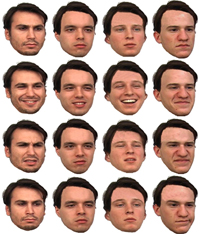May 31, 2011

Press Release: CMU Researchers Uncover How the Brain Processes Faces
Groundbreaking Study Identifies Neural System Responsible for Face Recognition
Contact: Shilo Raube / 412-268-6094 / sraube@andrew.cmu.edu
 PITTSBURGH—Each time you see a person that you know, your brain rapidly and seemingly effortlessly recognizes that person by his or her face.
PITTSBURGH—Each time you see a person that you know, your brain rapidly and seemingly effortlessly recognizes that person by his or her face.
Until now, scientists believed that only a couple of brain areas mediate facial recognition. However, Carnegie Mellon University's Marlene Behrmann, David Plaut and Adrian Nestor have discovered that an entire network of cortical areas work together to identify faces. Published in the current issue of the Proceedings of the National Academy of Sciences (PNAS), their findings will change the future of neural visual perception research and allow scientists to use this discovery to develop targeted remedies for disorders such as face blindness.
"This research will change the types of questions asked going forward because we are not just looking at one area of the brain," said Nestor, a postdoctoral research fellow within CMU's Department of Psychology and lead author of the study. "Now, scientists will have to account for the system as a whole or else our ability to understand face individuation will be limited."
Behrmann, professor of psychology and a renowned expert in using brain imaging to study prosopagnosia, or face blindness, agreed.
"Faces are among the most compelling visual stimulation that we encounter, and recognizing faces taxes our visual perception system to the hilt. Carnegie Mellon has a longstanding history for embracing a full-system account of the brain. We have the computational tools and technology to push further into looking past one single brain region. And, that is what we did here to discover that there are multiple cortical areas working together to recognize faces," she said.
For the study, participants were shown images of faces while in a magnetic resonance imaging (MRI) scanner. Their task was to recognize different facial identities with varying facial expressions. Using dynamic multivariate mapping, the research team examined the functional MRI (fMRI) data and found a network of fusiform and anterior temporal regions that respond with distinct patterns to different identities. Furthermore, they found that the information is evenly distributed among the anterior regions and that the right fusiform region plays a central role within the network.
"Not only do we have a more clearly defined architectural model of the brain, but we were able to determine the involvement of multiple brain areas in face recognition as well as in other types of processes, such as visual word recognition," Behrmann said.
This study was funded by the National Science Foundation, and Behrmann received additional support from the Weston Visiting Professorship at the Weizmann Institute of Science.
###
Pictured above, Stimuli were matched with respect to low-level properties, external features and high-level characteristics. Credit: Face images courtesy of the Face-Place Database Project, Copyright 2008, Michael J. Tarr
 PITTSBURGH—Each time you see a person that you know, your brain rapidly and seemingly effortlessly recognizes that person by his or her face.
PITTSBURGH—Each time you see a person that you know, your brain rapidly and seemingly effortlessly recognizes that person by his or her face.Until now, scientists believed that only a couple of brain areas mediate facial recognition. However, Carnegie Mellon University's Marlene Behrmann, David Plaut and Adrian Nestor have discovered that an entire network of cortical areas work together to identify faces. Published in the current issue of the Proceedings of the National Academy of Sciences (PNAS), their findings will change the future of neural visual perception research and allow scientists to use this discovery to develop targeted remedies for disorders such as face blindness.
"This research will change the types of questions asked going forward because we are not just looking at one area of the brain," said Nestor, a postdoctoral research fellow within CMU's Department of Psychology and lead author of the study. "Now, scientists will have to account for the system as a whole or else our ability to understand face individuation will be limited."
Behrmann, professor of psychology and a renowned expert in using brain imaging to study prosopagnosia, or face blindness, agreed.
"Faces are among the most compelling visual stimulation that we encounter, and recognizing faces taxes our visual perception system to the hilt. Carnegie Mellon has a longstanding history for embracing a full-system account of the brain. We have the computational tools and technology to push further into looking past one single brain region. And, that is what we did here to discover that there are multiple cortical areas working together to recognize faces," she said.
For the study, participants were shown images of faces while in a magnetic resonance imaging (MRI) scanner. Their task was to recognize different facial identities with varying facial expressions. Using dynamic multivariate mapping, the research team examined the functional MRI (fMRI) data and found a network of fusiform and anterior temporal regions that respond with distinct patterns to different identities. Furthermore, they found that the information is evenly distributed among the anterior regions and that the right fusiform region plays a central role within the network.
"Not only do we have a more clearly defined architectural model of the brain, but we were able to determine the involvement of multiple brain areas in face recognition as well as in other types of processes, such as visual word recognition," Behrmann said.
This study was funded by the National Science Foundation, and Behrmann received additional support from the Weston Visiting Professorship at the Weizmann Institute of Science.
###
Pictured above, Stimuli were matched with respect to low-level properties, external features and high-level characteristics. Credit: Face images courtesy of the Face-Place Database Project, Copyright 2008, Michael J. Tarr